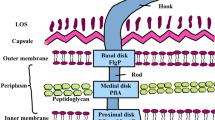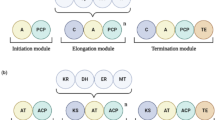Abstract
This study examined the effects of three lactic acid bacteria (LAB) strains on the nematode Caenorhabditis elegans. Lactobacillus salivarius, Lactobacillus reuteri, and Pediococcus acidilactici were found to inhibit the development and growth of the worm. Compared to Escherichia coli used as the control, L. reuteri and P. acidilactici reduced the lifespan of wild-type and short-lived daf-16 worms. On the contrary, L. salivarius extended the lifespan of daf-16 worms when used live, but reduced it as UV-killed bacteria. The three LAB induced the expression of genes involved in pathogen response and inhibited the growth of tumor-like germ cells, without affecting DAF16 localization or increasing corpse cells. Our results suggest the possible use of C. elegans as a model for studying the antitumor attributes of LAB. The negative effects of these LAB strains on the nematode also indicate their potential use against parasitic nematodes.









Similar content being viewed by others
References
Aballay A, Ausubel FM (2001) Programmed cell death mediated by ced-3 and ced-4 protects Caenorhabditis elegans from Salmonella typhimurium-mediated killing. PNAS 98:2735–2739. doi:10.1073/pnas.041613098
Aballay A, Yorgey P, Ausubel FM (2000) Salmonella typhimurium proliferates and establishes a persistent infection in the intestine of Caenorhabditis elegans. Curr Biol: CB 10:1539–1542
Abramoff MD, Magalhães Paulo J, Ram SJ (2004) Image processing with ImageJ. Biophoton Int 11:36–42
Alegado RA, Campbell MC, Chen WC, Slutz SS, Tan M-W (2003) Characterization of mediators of microbial virulence and innate immunity using the Caenorhabditis elegans host–pathogen model. Cell Microbiol 5:435–444. doi:10.1046/j.1462-5822.2003.00287.x
Alper S, McBride SJ, Lackford B, Freedman JH, Schwartz D (2007) Specificity and complexity of the Caenorhabditis elegans innate immune response. Mol Cell Biol 27:5544–5553. doi:10.1128/MCB.02070-06
Candela M, Guidotti M, Fabbri A, Brigidi P, Franceschi C, Fiorentini C (2011) Human intestinal microbiota: cross-talk with the host and its potential role in colorectal cancer. Crit Rev Microbiol 37:1–14. doi:10.3109/1040841X.2010.501760
Casas IA, Dobrogosz WJ (2000) Validation of the probiotic concept: Lactobacillus reuteri confers broad-spectrum protection against disease in humans and animals. Microb Ecol Health D 12:247–285
Couillault C, Ewbank JJ (2002) Diverse bacteria are pathogens of Caenorhabditis elegans. Infect Immun 70:4705. doi:10.1128/IAI.70.8.4705
Evans EA, Kawli T, Tan M-W (2008) Pseudomonas aeruginosa suppresses host immunity by activating the DAF-2 insulin-like signaling pathway in Caenorhabditis elegans. PLoS Pathog 4:e1000175. doi:10.1371/journal.ppat.1000175
Ferguson RMW, Merrifield DL, Harper GM, Rawling MD, Mustafa S, Picchietti S, Balcázar JL, Davies SJ (2010) The effect of Pediococcus acidilactici on the gut microbiota and immune status of on-growing red tilapia (Oreochromis niloticus). J Appl Microbiol 109:851–862. doi:10.1111/j.1365-2672.2010.04713.x
Francis R, Barton MK, Kimble J, Schedl T (1995) gld-1, a tumor suppressor gene required for oocyte development in Caenorhabditis elegans. Genetics 139:579–606
Galvez J, Arribas B, Rodríguez-Cabezas ME, Bailon E, Comalada M, Camuesco D, Xaus J, Zarzuelo A (2008) Immunomodulatory properties of Lactobacillus salivarius are not limited to the intestine. P Nutr Soc 67:E40. doi:10.1017/S0029665108006496
Garigan D, Hsu A, Fraser A, Kamath R (2002) Genetic analysis of tissue aging in Caenorhabditis elegans: a role for heat-shock factor and bacterial proliferation. Genetics 16:1101–1112
Garsin DA, Sifri CD, Mylonakis E, Qin X, Singh KV, Murray BE, Calderwood SB, Ausubel FM (2001) A simple model host for identifying Gram-positive virulence factors. PNAS 98:10892–10897. doi:10.1073/pnas.191378698
Gerritsen J, Smidt H, Rijkers GT, de Vos WM (2011) Intestinal microbiota in human health and disease: the impact of probiotics. Genes Nutr 6(3):209–240. doi:10.1007/s12263-011-0229-7
Gill H (2003) Probiotics to enhance anti-infective defences in the gastrointestinal tract. Best Pract Res Cl Ga 17:755–773. doi:10.1016/S1521-6918(03)00074-X
Gilleard JS (2004) The use of Caenorhabditis elegans in parasitic nematode research. Parasitology 128(Suppl 1):S49–S70. doi:10.1017/S003118200400647X
Glass MD, Courtney PD, LeJeune JT, Ward LA (2004) Effects of Lactobacillus acidophilus and Lactobacillus reuteri cell-free supernatants on Cryptosporidium viability and infectivity in vitro. Food Microbiol 21:423–429. doi:10.1016/j.fm.2003.11.001
Gumienny TL, Lambie E, Hartwieg E, Horvitz HR, Hengartner MO (1999) Genetic control of programmed cell death in the Caenorhabditis elegans hermaphrodite germline. Development 126:1011–1022
Honda Y, Fujita Y, Maruyama H, Araki Y, Ichihara K, Sato A, Kojima T, Tanaka M, Nozawa Y, Ito M, Honda S (2011) Lifespan-extending effects of royal jelly and its related substances on the nematode Caenorhabditis elegans. PLoS One 6:e23527. doi:10.1371/journal.pone.0023527
Houthoofd K, Gems D, Johnson TE, Vanfleteren JR (2007) Dietary restriction in the nematode Caenorhabditis elegans. Interdisc Topics Ger 35:98–114. doi:10.1159/000096558
Hsu A-L, Murphy CT, Kenyon C (2003) Regulation of aging and age-related disease by DAF-16 and heat-shock factor. Science (New York, NY) 300:1142–1145. doi:10.1126/science.1083701
Ikeda T, Yasui C, Hoshino K, Arikawa K, Nishikawa Y (2007) Influence of lactic acid bacteria on longevity of Caenorhabditis elegans and host defense against Salmonella enterica serovar enteritidis. Appl Environ Microb 73:6404–6409. doi:10.1128/AEM.00704-07
Iyer C, Kosters A, Sethi G, Kunnumakkara AB, Aggarwal BB, Versalovic J (2008) Probiotic Lactobacillus reuteri promotes TNF-induced apoptosis in human myeloid leukemia-derived cells by modulation of NF-kappaB and MAPK signalling. Cell Microbiol 10:1442–1452. doi:10.1111/j.1462-5822.2008.01137.x
Kaeberlein TL, Smith ED, Tsuchiya M, Welton KL, Thomas JH, Fields S, Kennedy BK, Kaeberlein M (2006) Lifespan extension in Caenorhabditis elegans by complete removal of food. Aging cell 5:487–494. doi:10.1111/j.1474-9726.2006.00238.x
Komura T, Yasui C, Miyamoto H, Nishikawa Y (2010) Caenorhabditis elegans as an alternative model host for Legionella pneumophila, and protective effects of Bifidobacterium infantis. Appl Environ Microb 76:4105–4108. doi:10.1128/AEM.03021-09
Kumar M, Kumar A, Nagpal R, Mohania D, Behare P, Verma V, Kumar P, Poddar D, Aggarwal PK, Henry CJK, Jain S, Yadav H (2010) Cancer-preventing attributes of probiotics: an update. Int J Food Sci Nutr 61:473–496. doi:10.3109/09637480903455971
Labrousse A, Chauvet S, Couillault C, Kurz CL, Ewbank JJ (2000) Caenorhabditis elegans is a model host for Salmonella typhimurium. Curr Biol: CB 10:1543–1545
Langa S, Maldonado-Barragán A, Delgado S, Martín R, Martín V, Jiménez E, Ruíz-Barba JL, Mayo B, Connor RI, Suárez JE, Rodríguez JM (2012) Characterization of Lactobacillus salivarius CECT 5713, a strain isolated from human milk: from genotype to phenotype. Appl Microbiol Biot 94(5):1279–1287. doi:10.1007/s00253-012-4032-1
Mahajan-Miklos S, Rahme LG, Ausubel FM (2000) Elucidating the molecular mechanisms of bacterial virulence using non-mammalian hosts. Mol Microbiol 37:981–988
Mallo GV, Kurz CL, Couillault C, Pujol N, Granjeaud S, Kohara Y, Ewbank JJ (2002) Inducible antibacterial defense system in C. elegans. Curr Biol: CB 12:1209–1214
Murphy C, McCarroll S, Bargmann C, Fraser A, Kamath RS, Ahringer J, Li H, Kenyon C (2003) Genes that act downstream of DAF-16 to influence the lifespan of Caenorhabditis elegans. Nature 424(6946):277–283
Nakajima H, Toba T, Ito A, Kudo S, Sato S, Sato Y (2003) The screening of hydrogen peroxide-producing lactic acid bacteria and their application to inactivating psychrotrophic food-borne pathogens. Curr Microbiol 47:231–236. doi:10.1007/s00284-002-3993-1
Ottaviani E, Ventura N, Mandrioli M, Candela M, Franchini A, Franceschi C (2011) Gut microbiota as a candidate for lifespan extension: an ecological/evolutionary perspective targeted on living organisms as metaorganisms. Biogerontology 12(6):599–609. doi:10.1007/s10522-011-9352-5
Pagnini C, Saeed R, Bamias G, Arseneau KO, Pizarro TT, Cominelli F (2010) Probiotics promote gut health through stimulation of epithelial innate immunity. PNAS 107:454–459. doi:10.1073/pnas.0910307107
Perdigón G, Maldonado Galdeano C, Valdez JC, Medici M (2002) Interaction of lactic acid bacteria with the gut immune system. Eur J Clin Nutr 56(Suppl 4):S21–S26. doi:10.1038/sj.ejcn.1601658
Putaala H, Barrangou R, Leyer GJ, Ouwehand AC, Hansen EB, Romero DA, Rautonen N (2010) Analysis of the human intestinal epithelial cell transcriptional response to Lactobacillus acidophilus, Lactobacillus salivarius, Bifidobacterium lactis and Escherichia coli. Beneficial microbes 1:283–295. doi:10.3920/BM2010.0003
Singh V, Aballay A (2009) Regulation of DAF-16-mediated innate immunity in Caenorhabditis elegans. J Biol Chem 284:35580–35587. doi:10.1074/jbc.M109.060905
Stiernagle T (2006) Maintenance of C. elegans. WormBook: Online Rev C elegans Biol 11:1–11. doi:10.1895/wormbook.1.101.1
Sutphin GL, Kaeberlein M (2009) Measuring Caenorhabditis elegans life span on solid media. J Vis Exp. doi:10.3791/1152
Sutphin GL, Kaeberlein M (2008) Dietary restriction by bacterial deprivation increases life span in wild-derived nematodes. Exp Gerontol 43:130–135. doi:10.1016/j.exger.2007.10.019
Sánchez-Blanco A, Kim SK (2011) Variable pathogenicity determines individual lifespan in Caenorhabditis elegans. PLoS genetics 7:e1002047. doi:10.1371/journal.pgen.1002047
Takata K, Kinoshita M, Okuno T, Moriya M, Kohda T, Honorat JA, Sugimoto T, Kumanogoh A, Kayama H, Takeda K, Sakoda S, Nakatsuji Y (2011) The lactic acid bacterium Pediococcus acidilactici suppresses autoimmune encephalomyelitis by inducing IL-10-producing regulatory T cells. PLoS One 6:e27644. doi:10.1371/journal.pone.0027644
Talarico T, Casas I, Chung TC, Dobrogosz W (1988) Production and isolation of reuterin, a growth inhibitor produced by Lactobacillus reuteri. Antimicrob Agents Ch 32:1854. doi:10.1128/AAC.32.12.1854.Updated
Tan M-W, Shapira M (2011) Genetic and molecular analysis of nematode–microbe interactions. Cell Microbiol 13:497–507. doi:10.1111/j.1462-5822.2011.01570.x
Taverniti V, Guglielmetti S (2011) The immunomodulatory properties of probiotic microorganisms beyond their viability (ghost probiotics: proposal of paraprobiotic concept). Genes Nutr 6:261–274. doi:10.1007/s12263-011-0218-x
Tierney J, Gowing H, Van Sinderen D, Flynn S, Stanley L, McHardy N, Hallahan S, Mulcahy G (2004) In vitro inhibition of Eimeria tenella invasion by indigenous chicken Lactobacillus species. Vet Parasitol 122:171–182. doi:10.1016/j.vetpar.2004.05.001
Travers M-A, Florent I, Kohl L, Grellier P (2011) Probiotics for the control of parasites: an overview. J Parasitol Res 2011:610769. doi:10.1155/2011/610769
Wang C, Wang J, Gong J, Yu H, Pacan JC, Niu Z, Si W, Sabour PM (2011) Use of Caenorhabditis elegans for preselecting Lactobacillus isolates to control Salmonella typhimurium. J Food Protect 74:86–93. doi:10.4315/0362-028X.JFP-10-155
Wilson MA, Rimando AM, Wolkow CA (2008) Methoxylation enhances stilbene bioactivity in Caenorhabditis elegans. BMC Pharmacol 8:15. doi:10.1186/1471-2210-8-15
Zhang Y, Lu H, Bargmann CI (2005) Pathogenic bacteria induce aversive olfactory learning in Caenorhabditis elegans. Nature 438:179–184. doi:10.1038/nature04216
Author information
Authors and Affiliations
Corresponding author
Rights and permissions
About this article
Cite this article
Fasseas, M.K., Fasseas, C., Mountzouris, K.C. et al. Effects of Lactobacillus salivarius, Lactobacillus reuteri, and Pediococcus acidilactici on the nematode Caenorhabditis elegans include possible antitumor activity. Appl Microbiol Biotechnol 97, 2109–2118 (2013). https://doi.org/10.1007/s00253-012-4357-9
Received:
Revised:
Accepted:
Published:
Issue Date:
DOI: https://doi.org/10.1007/s00253-012-4357-9




